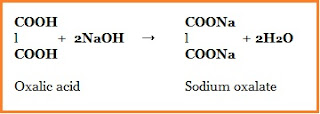Aim:
Requirements:
Theory:
Preparation of 0.1M oxalic acid solution:
Titration procedure:
- All glassware should be cleaned and dried according to standard laboratory procedures.
- Before filling the burette for the titration, rinse it with distilled water and then pre-rinse it with a portion of the titrant solution. Pre-rinsing is required to make sure that all solution in the burette is the desired solution, not a contaminated or diluted solution.
- Take the unknown stock solution of titrant in a clean and dry beaker then fill the burette using the funnel.
- Remove air bubbles from the burette and adjust the reading to zero.
- Take 10.00 ml of prepared 10 mL of oxalic acid solution and pour it into a conical flask.
- Add 2-3 drops of phenolphthalein indicator.
- Titrate the acid with sodium hydroxide solution (NaOH) till a very faint permanent pink colour is obtained.
- Properly record the readings of the burette.
- To get accurate results, repeat the titration three times.
- The following equation can be used to determine the molarity of a NaOH solution.
Observation table:
|
Sr. No. |
Content in
conical flask |
Burette
reading |
Volume of
titrant used (ml) |
|
|
Initial |
Final |
|||
|
1 |
|
|
|
|
|
2 |
|
|
|
|
|
3 |
|
|
|
|
|
|
Mean: |
|||
Calculations:
a1 M1V1 = a2 M2V2
where M1 and V1 are the molarity and volume of the oxalic
acid solution.
M2 and V2 are the molarity and volume of the sodium
hydroxide solution.
Result:
The strength of the prepared NaOH solution was found to be_____M.
You may also like this:
Importance of titration in chemistry
What is the process of titration?
Definitions and basic terms used in titration
Why is titration known as volumetric analysis?
Volumetric Analysis: Principle, Types, Procedure & Applications
Sources of error in titration
What solution usually goes in the burette in titration?
Standardization of NaOH with oxalic acid
Standardization of NaOH with KHP
Standardization of HCl solution

No comments:
Post a Comment